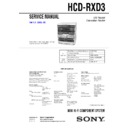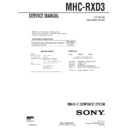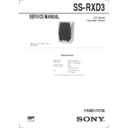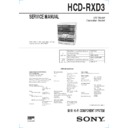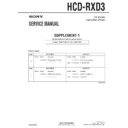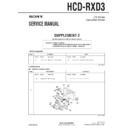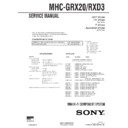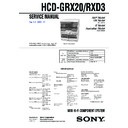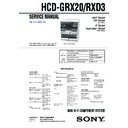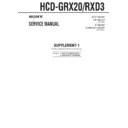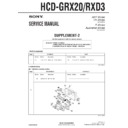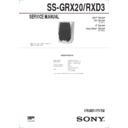Read Sony HCD-RXD3 / MHC-RXD3 (serv.man2) Service Manual online
HCD-RXD3
US Model
Canadian Model
SERVICE MANUAL
MINI Hi-Fi COMPONENT SYSTEM
SPECIFICATIONS
HCD-RXD3 is the tuner, deck, CD and
amplifier section in MHC-RXD3.
amplifier section in MHC-RXD3.
Model Name Using Similar Mechanism
HCD-RX55
CD Mechanism Type
CX3
Base Unit Type
KSM-213ECM
Optical Pick-up Type
KSS-213ECM/C2NP
Model Name Using Similar Mechanism
NEW
Tape Transport Mechanism Type
CWL-44-FR
CD
SECTION
TAPE
DECK
SECTION
Ver 1.1 2003. 05
Sony Corporation
Home Audio Company
Published by Sony Engineering Corporation
9-928-882-12
2003E16-1
© 2003.05
AUDIO POWER SPECIFICATIONS:
(U.S.A. model only)
(U.S.A. model only)
POWER OUTPUT AND TOTAL
HARMONIC DISTORTION:
HARMONIC DISTORTION:
with 6
Ω loads both channels driven, from 70 –
20,000 Hz; rated 50 W per channel minimum RMS
power, with no more than 0.9% total harmonic
distortion from 250 mW to rated output.
power, with no more than 0.9% total harmonic
distortion from 250 mW to rated output.
Amplifier section
Continuous RMS power output
60W + 60W
(6
(6
Ω at 1 kHz, 10%
THD)
Inputs
MD IN (phono jack):
voltage 450mV,
impedance 47 k
impedance 47 k
Ω
Outputs
MD OUT (phono jacks):
voltage 250mV
impedance 1k
impedance 1k
Ω
PHONES (stereo phone jack):
accepts headphones of
8
8
Ω or more.
SPEAKER:
accepts impedance of
6 to 16
6 to 16
Ω
CD player section
System
Compact disc and digital
audio system
audio system
Laser
Semiconductor laser
(
(
λ = 780 nm)
Emission duration:
continuous
continuous
Laser output
Max. 44.6µW*
*This output is the value
measured at a distance of
200 mm from the
objective lens surface on
the Optical Pock-up
Block with 7 mm
aperture.
*This output is the value
measured at a distance of
200 mm from the
objective lens surface on
the Optical Pock-up
Block with 7 mm
aperture.
Frequency response
20Hz – 20kHz (±0.5 dB)
Wavelength
780 – 790 nm
DIGITAL OUT (OPTICAL)
(Square optical connector jack, rear panel)
Wavelength
(Square optical connector jack, rear panel)
Wavelength
600 nm
Output Level
–18 dBm
Tape deck section
Recording system
4-track 2-channel stereo
Frequency response
40 – 13,000 Hz (±3 dB),
using Sony TYPE I
cassette
using Sony TYPE I
cassette
Tuner section
FM stereo, FM/AM superheterodyne tuner
FM tunr section
Tuning range
87.5 – 108.0 MHz
Antenna
FM lead antenna
Antenna terminals
75
Ω unbalanced
Intermediate frequency
10.7 MHz
AM tuner section
Tuning renge
531 – 1,602 kHz
(with AM tuning interval
set at 9 kHz)
530 – 1,710 kHz
(with AM tuning interval
set at 10 kHz)
(with AM tuning interval
set at 9 kHz)
530 – 1,710 kHz
(with AM tuning interval
set at 10 kHz)
Antenna
AM loop antenna
Antenna terminals
External antenna
terminal
terminal
Intermediate frequency
450 kHz
— Continued on next page —
— 2 —
After correcting the original service problem, perform the following
safety checks before releasing the set to the customer:
Check the antenna terminals, metal trim, “metallized” knobs, screws,
and all other exposed metal parts for AC leakage. Check leakage as
described below.
safety checks before releasing the set to the customer:
Check the antenna terminals, metal trim, “metallized” knobs, screws,
and all other exposed metal parts for AC leakage. Check leakage as
described below.
LEAKAGE
The AC leakage from any exposed metal part to earth ground and
from all exposed metal parts to any exposed metal part having a
return to chassis, must not exceed 0.5 mA (500 microamperes).
Leakage current can be measured by any one of three methods.
from all exposed metal parts to any exposed metal part having a
return to chassis, must not exceed 0.5 mA (500 microamperes).
Leakage current can be measured by any one of three methods.
1.
A commercial leakage tester, such as the Simpson 229 or RCA
WT-540A. Follow the manufacturers’ instructions to use these
instruments.
WT-540A. Follow the manufacturers’ instructions to use these
instruments.
2.
A battery-operated AC milliammeter. The Data Precision 245
digital multimeter is suitable for this job.
digital multimeter is suitable for this job.
3.
Measuring the voltage drop across a resistor by means of a
VOM or battery-operated AC voltmeter. The “limit” indication
is 0.75 V, so analog meters must have an accurate low-voltage
scale. The Simpson 250 and Sanwa SH-63Trd are examples of
a passive VOM that is suitable. Nearly all battery operated
digital multimeters that have a 2V AC range are suitable. (See
Fig. A)
VOM or battery-operated AC voltmeter. The “limit” indication
is 0.75 V, so analog meters must have an accurate low-voltage
scale. The Simpson 250 and Sanwa SH-63Trd are examples of
a passive VOM that is suitable. Nearly all battery operated
digital multimeters that have a 2V AC range are suitable. (See
Fig. A)
SAFETY CHECK-OUT
To Exposed Metal
Parts on Set
0.15
µ
F
1.5 k
Ω
AC
Voltmeter
(0.75 V)
Voltmeter
(0.75 V)
Earth Ground
Fig. A. Using an AC voltmeter to check AC leakage.
This appliance is classified as a CLASS 1 LASER product. The
CLASS 1 LASER PRODUCT MARKING is located on the rear
exterior.
CLASS 1 LASER PRODUCT MARKING is located on the rear
exterior.
Laser component in this product is capable of emitting radiation
exceeding the limit for Class 1.
exceeding the limit for Class 1.
CAUTION
Use of controls or adjustments or performance of procedures
other than those specified herein may result in hazardous radiation
exposure.
other than those specified herein may result in hazardous radiation
exposure.
Notes on chip component replacement
• Never reuse a disconnected chip component.
• Notice that the minus side of a tantalum capacitor may be
• Notice that the minus side of a tantalum capacitor may be
damaged by heat.
Flexible Circuit Board Repairing
• Keep the temperature of soldering iron around 270˚C
during repairing.
• Do not touch the soldering iron on the same conductor of the
circuit board (within 3 times).
• Be careful not to apply force on the conductor when soldering
or unsoldering.
SAFETY-RELATED COMPONENT WARNING!!
COMPONENTS IDENTIFIED BY MARK
!
OR DOTTED LINE WITH
MARK
!
ON THE SCHEMATIC DIAGRAMS AND IN THE PARTS
LIST ARE CRITICAL TO SAFE OPERATION. REPLACE THESE
COMPONENTS WITH SONY PARTS WHOSE PART NUMBERS
APPEAR AS SHOWN IN THIS MANUAL OR IN SUPPLEMENTS
PUBLISHED BY SONY.
COMPONENTS WITH SONY PARTS WHOSE PART NUMBERS
APPEAR AS SHOWN IN THIS MANUAL OR IN SUPPLEMENTS
PUBLISHED BY SONY.
ATTENTION AU COMPOSANT AYANT RAPPORT
À LA SÉCURITÉ!
LES COMPOSANTS IDENTIFÉS PAR UNE MARQUE
!
SUR LES
DIAGRAMMES SCHÉMATIQUES ET LA LISTE DES PIÈCES SONT
CRITIQUES POUR LA SÉCURITÉ DE FONCTIONNEMENT. NE
REMPLACER CES COMPOSANTS QUE PAR DES PIÈSES SONY
DONT LES NUMÉROS SONT DONNÉS DANS CE MANUEL OU
DANS LES SUPPÉMENTS PUBLIÉS PAR SONY.
CRITIQUES POUR LA SÉCURITÉ DE FONCTIONNEMENT. NE
REMPLACER CES COMPOSANTS QUE PAR DES PIÈSES SONY
DONT LES NUMÉROS SONT DONNÉS DANS CE MANUEL OU
DANS LES SUPPÉMENTS PUBLIÉS PAR SONY.
General
Power requirements
120V AC, 60Hz
Power consumption
105W
Dimensions (w/h/d) incl. projecting parts and controls
Approx. 280
×
320
×
400 mm
(11
1
/8
×
12
5
/8
×
15
3
/4 in)
Mass
Approx. 9kg (19 lb 13 oz.)
Supplied accessories:
AM loop antenna (1)
FM lead antenna (1)
Remote (1)
Plug adaptor (for Asian model) (1)
FM lead antenna (1)
Remote (1)
Plug adaptor (for Asian model) (1)
Design and specifications are subject to change without notice.
— 3 —
TABLE OF CONTENTS
1. GENERAL
·········································································· 4
2. DISASSEMBLY
2-1.
CD Door ············································································· 5
2-2.
Front Panel ········································································· 6
2-3.
Main Board ········································································· 6
2-4.
Amplifier Board ································································· 7
2-5.
CD Tray ·············································································· 7
2-6.
Decord Board ····································································· 8
2-7.
Base Unit ············································································ 9
2-8.
Cassette Lid ········································································ 9
3. TEST MODE
···································································· 10
4. MECHANICAL ADJUSTMENTS
····························· 11
5. ELECTRICAL ADJUSTMENTS
······························· 11
6. DIAGRAMS
6-1.
Circuit Boards Location ··················································· 16
6-2.
Block Diagrams ································································ 17
Main Section ····································································· 17
Tuner, CD Section ···························································· 19
Main Section ····································································· 17
Tuner, CD Section ···························································· 19
6-3.
Printed Wiring Board Main Section ······························· 23
6-4.
Schematic Diagram Main (1/3) Section ························· 25
6-5.
Schematic Diagram Main (2/3) Section ························· 27
6-6.
Schematic Diagram Main (3/3) Section ························· 29
6-7.
Printed Wiring Board Front Panel Section ····················· 31
6-8.
Schematic Diagram Front Panel Section ························ 33
6-9.
Printed Wiring Board Amplifier Section ························ 35
6-10. Schematic Diagram Amplifier Section ··························· 37
6-11. Printed Wiring Board CD Section ·································· 39
6-12. Schematic Diagram CD Section ····································· 41
6-13. IC Pin Function ································································ 43
6-14. IC Block Diagrams ··························································· 45
6-11. Printed Wiring Board CD Section ·································· 39
6-12. Schematic Diagram CD Section ····································· 41
6-13. IC Pin Function ································································ 43
6-14. IC Block Diagrams ··························································· 45
7. EXPLODED VIEWS
7-1.
Cabinet Section ································································· 49
7-2.
Front Panel Section ·························································· 50
7-3.
CD Mechanism Deck Section-1 ······································· 51
7-4.
CD Mechanism Deck Section-2 ······································· 52
7-5.
Base Unit Section (KSM-213ECM) ································· 53
8. ELECTRICAL PARTS LIST
······································· 54
— 4 —
4
3
2
#¡
@¶
@•
@§
@∞
@¢
@£
@™
@¡
@º
!ª
!§
!∞
!¶
!¶
!•
!¢
!£
!™
5
6
7
8
9
!º
!¡
!¡
1
#£
#™
#£
#™
#º
@ª
@ª
1
1/u (Power) button
2
TIMER SELECT button
3
CLOCK/TIMER SET button
4
( (TAPE A) button
5
9 (TAPE B) button
6
( (TAPE B) button
7
p (STOP) button
8
^ (CD) button
9
DISPLAY/DEMO button
!º
FUNCTION button
!¡
TUNER/BAND button
!™
+ button
!£
+ + button
!¢
CD SYNC button
!∞
PAUSE button
!§
REC button
!¶
6 OPEN/CLOSE button
!•
DISC SKIP/EX-CHANGE button
!ª
DISC 3 button
@º
DISC 2 button
@¡
DISC 1 button
@™
DECK B
@£
ENTER/NEXT button
@¢
VOLUME knob
@∞
DECK A
@§
REPEAT/STEREO/MONO button
@¶
PLAY MODE/TUNER MEMORY button
@•
EDIT/DIRECTION button
@ª
DBFB button
#º
FILE SELECT button
#¡
PHONES jack
#™
= – button
#£
= button
SECTION 1
GENERAL

